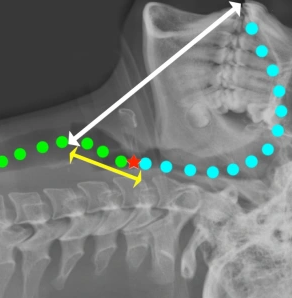Sniffing Position Meaning, Airway, Intubation - Sniffing Position vs Neutral Position
Sniffing Position Meaning
Endotracheal intubation is performed by flexing the neck and extending the head at the atlantooccipital joint. This posture is known as the sniffing position, and it is a head and neck position that is used during the procedure.
Endotracheal intubation can be successfully performed with it. The sniffing position can be described as a supine position with neck flexion and head extension, irrespective of the type of headrest utilized.
The sniffing position has several advantages:
- During direct laryngoscopy, it enhances laryngeal exposure, especially in obese patients.
- In patients with obstructive sleep apnea, it enhances the structural integrity of the passive pharyngeal airway.
- It enhances the laryngoscopic view, which makes endotracheal intubation easier.

Sniffing Position Airway
- The sniffing posture, which combines neck flexion and head extension, is considered appropriate for endotracheal intubation.
- The sniffing position makes endotracheal intubation easier and enhances laryngoscopic vision.
- At the retropalatal and hypopharyngeal levels, the inhaling position has been observed to affect airway collapsibility.
- Anesthesia practices for neonates and children universally adhere to the sniffing position as a standard procedure.
Sniffing Position Intubation
The sniffing position is a technique for optimizing the alignment of the patient's head and neck during endotracheal intubation. It combines head extension with neck flexion, usually accomplished by supporting the patient's occiput with a pillow. Studies have indicated that adopting the sniffing position can enhance the laryngoscopic vision and make endotracheal intubation easier.
It is well-established that the sniffing position improves the efficacy of endotracheal tube insertion and laryngoscopy, in addition to complementing other airway optimization strategies.
Sniffing Position vs Neutral Position
In order to regulate airways during anesthesia, two distinct head and neck positions are utilized: the neutral position and the sniffing position. In order to align the oral, pharyngeal, and laryngeal axes, the sniffing position requires extending the neck and bringing the head forward; conversely, the neutral position entails reclining flat without the use of a pillow.
It has been widely believed that the sniffing position is the best position for direct laryngoscopy; however, new research has demonstrated that the neutral position can improve the view of the glottic aperture during oral fiberoptic intubation and nasotracheal intubation when using a GlideScope video laryngoscope.
 Reviewed by Simon Albert
on
January 16, 2024
Rating:
Reviewed by Simon Albert
on
January 16, 2024
Rating:











